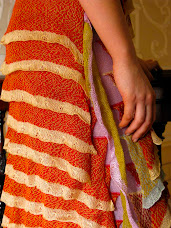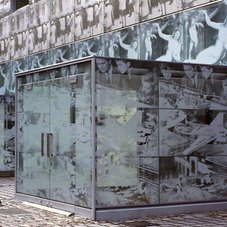 In the course of retrofitting existing adobe structures in New Mexico to become sustainable, ecomodista has been researching various approaches. Michael Reynolds, in Taos, New Mexico has been constructing affordable homes since the late 1970’s by using recycled aluminum cans, bottles, and discarded tires in conjunction with rammed earth.
In the course of retrofitting existing adobe structures in New Mexico to become sustainable, ecomodista has been researching various approaches. Michael Reynolds, in Taos, New Mexico has been constructing affordable homes since the late 1970’s by using recycled aluminum cans, bottles, and discarded tires in conjunction with rammed earth.Reynolds describes his work as, biotecture, and explains, “Earthships are made when a hole is excavated into a slope, then tires are laid in a brick-like pattern and filled with compacted soil. The tires swell and interlock under the pressure of manually rammed earth, becoming very thick and resilient. Chinks between tires are stuffed with partially crushed, used aluminum cans. Like an adobe wall, integrity is further secured by a bond-beam atop the wall. Roofing consists of the classic vigas (large wooden girders) and latillas, or modern laminated beams, along with plywood and foam sheathing. A sloping glass wall along the front, oriented generally to the south, exposes the thermal mass of the tire-and-earth frame to direct solar gain. Exterior walls and rounded, sculpted interior surfaces are plastered and painted to look like adobe and rammed earth homes. Earthships are often designed to be completely self-sufficient: water from roof catchments, photovoltaic electricity, and innovative indoor waste disposal are all common features. Effective passive solar design can keep a well-balanced earthship hovering around 65F with no expenditure of energy, winter and summer.”
Biotecture appears to be a sensible approach and the use of indigenous materials (given their pervasiveness, aluminum cans, bottles, and tires may also be considered inherent in a region's resources) is energy efficient. During the Public Works Administration era, public buildings were designed by regional architects and use of regional materials was mandatory. Recycling materials locally as building materials may be more cost effective than closed loop.
In 2003, 54 billion aluminum cans were recycled within a closed loop, saving energy equivalent to 15 million barrels of crude oil - America's entire gas consumption for one day. Since aluminum and glass are relatively inert, use as construction materials poses little health hazard. Using tires in construction may be problematic, since petrochemicals are integral to manufacturing this product, and these chemicals leach into the ground over a period of time. Fires occurring where scrapped tires are stored are extremely toxic and various state environmental agencies have focused on reducing scrap by recycling. Currently, 80% of scrapped tires are recycled as fuel to power cement kilns (and we will be discussing cement kilns), pulp and paper mills, power plants, waste-to-energy plants and industrial boilers.http://www.dnr.state.oh.us/recycling/awareness/facts/tires/
While energy efficiency is critical and we want to explore working with rammed earth, ecomodista prefers a sleeker contemporary appearance. Reynolds has argued that the appearance and aesthetics of earthships should not be the issue, but there will be consumers demanding that ecological principles are merged with euro/american modernism. Reynold’s ethic is directed to those who want to build their own homes and become as self sustainable as possible, if not off the grid using easily available materials and technology. Reynolds is truly a pioneer, and has made important contributions to sustainable architecture, disseminating earthships globally.
Adobe and rammed earth are inert and easily replenished building materials composed of granite and caliche (calcium carbonate or decomposed limestone soil). Frank Lloyd Wright’s textile block houses in Los Angeles utilize site specific soil to manufacture the blocks, to harmonize with the natural landscape. Lime, portland cement, and pozzolana ( originally volcanic ash mortar) are used to modify clay soil, the most effective being lime which is often used in conjunction with portland cement. Lime is inexpensive, but workers must wear respirators to avoid pulmonary damage from lime or cement dust. Since 9/11, OSHA has a poor record enforcing existing regulations regarding such exposure, at least in New York City. Cement is relatively inexpensive, but has massive energy requirements during production, however, cement produces the strongest bond. Adobe and rammed earth with minimal cement additives have low embodied energy (the energy consumed by all of the processes associated with the production of a material, from the acquisition of natural resources to product delivery) and less impact than concrete and lumber products.
The environmental impact of cement kilns is massive, which is unmitigated at last investigation. As of 2005, Potential environmental impact of mercury emissions from Portland cement kilns by R.O. Richter & P.J. Sheehan found, "The reduction of mercury (Hg) releases to the environment, particularly airborne mercury emissions, is currently a major focus of both US state and federal regulatory agencies. While mercury emissions from hazardous waste incinerators and fossil-fuel power plants have been and continue to be regulated under the Resource Conservation and Recovery Act (RCRA) and the Clean Air Act (CAA), non-hazardous waste cement kilns are currently excluded from regularly controls."
As early as 1992, RACHEL'S HAZARDOUS WASTE NEWS #314 reported cement kiln dust contains dioxins and furans (both hazmats are extremely dangerous), according an EPA report, that also found 20% of the kiln dust that the EPA tested contains radioactive elements plutonium-238, plutonium-239 and cesium-137. Dioxins and plutonium are extremely carcinogenic. http://www.ejnet.org/rachel/rhwn314a.htm If this is interesting, do refer to U.S. Congress, Office of Technology Assessment, Managing Industrial Solid Wastes From Manufacturing, Mining, Oil and Gas Production, and Utility Coal Combustion-Background Paper, OTA-BP-O-82 (Washington, DC: U.S. Government Printing Office, February 1992).http://govinfo.library.unt.edu/ota/Ota_1/DATA/1992/9225.PDF So essentially, the problem with cement is its production or destruction, as the collapse of the World Trade Center towers demonstrated.
Kramer Woodard, the architect of the bathroom we are renovating, is using a generic material, Durock, as a surface cladding, normally used as a backing for tile work. When standing vertically, it has a calligraphic appearance. Woodard is using Durock horizontally to work with the module size of the material. We like the contrast of rough board and sleek aluminum, and when the bath is finished, ecomodista will post images. Endur-O-Seal, http://www.concretesealants.com/Concrete_Sealeants.htm, an environmentally compatible sealer with a self binding catalyst will be applied to the Durock to seal and protect the material from moisture before being attached to the walls.
See Sweets for Durock technical data: http://sweets.construction.com/mfg/2112/P33332.htm
There are other problems with adobe construction, since the use of stucco exteriors seem to be endemic; the alternative is to use mud. Albert Parra, our adobe expert, believes traditional buildings, such as moradas, should use mud, and that the annual application of an external finish reinforces the communal experience of adobe construction. Parra believes adobe buildings are living entities that change with the seasons, and devotion to their maintenance is an affirmation of life.







